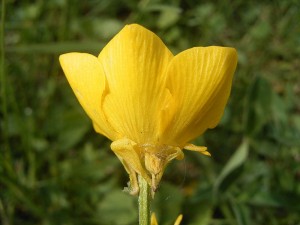The buttercup or crowfoot family, Ranunculaceae which in latin means Little frog is linked to their tendancy to be found near water, like frogs. The three common Ranunculus species found on campus are grassland species and can easily be identified as follows.
The Meadow buttercup Ranunculus acris has hairy stems and leaves which are normally palmately divided (with five segments or lobes like the palm of your hand). The flower has five sepals and five yellow overlapping petals with numerous carpels and numerous stamens and the fruit is an achene. This species is most commonly found in meadows which are mown or grazed and on campus is most frequent in the annually mown grasslands on the western side of Whiteknights Lake.
The Creeping buttercup Ranunculus repens has deep green leaves divided into three leaflets – usually with pale green or whitish markings – and the terminal lobe has a short stalk. This plant is a common weed and will happily grow in disturbed and damp ground and is often found on roadsides and verges and on campus is most abundant in the wetter grasslands around Whiteknights Lake.
The final species is the Bulbous buttercup, Ranunculus bulbosus, which has 5-7 bright yellow petals and can be easily distinguished from the other two species by its downturned (reflexed) sepals. The basal leaves are divided into three leaflets arising from a slightly hairy stem. This is a short plant with a large bulb (more accurately a corm) which sits just below the soil surface. Found in drier areas than R. acris or R. repens such as well drained grasslands and sand dunes and on campus is most conspicuous on the drier grassy slopes on the eastern side of Whiteknights Lake.
Image Credits:
http://commons.wikimedia.org/wiki/File:RanunculusAcris.jpg
http://commons.wikimedia.org/wiki/File:Ranunculus_repens_01_ies.jpg
http://commons.wikimedia.org/wiki/File:Ranunculus_bulbosus_bloem.jpg



